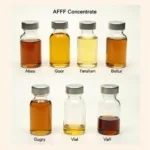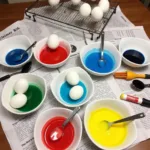Gel food coloring is becoming increasingly popular for baking and decorating, but does gel food coloring work for dying eggs? The short answer is: absolutely! Using gel food coloring for dyeing eggs can create vibrant and rich colors, often surpassing the results achieved with traditional liquid dyes.
Unleashing Vibrant Hues with Gel Food Coloring
Dyeing eggs is a cherished tradition for many, and using gel food coloring can elevate your egg decorating game. Unlike liquid food coloring, which can be watery and sometimes produce pale results, gel food coloring is highly concentrated. This means a little goes a long way, delivering deep, intense colors that really pop. Whether you’re aiming for pastel shades or bold, jewel-toned eggs, gel food coloring offers a wide range of possibilities. It’s a fantastic alternative for those seeking richer, more vibrant egg colors.
How to Use Gel Food Coloring for Egg Dyeing
The process of using gel food coloring for dyeing eggs is similar to using liquid dyes, but with a few key differences. First, you’ll need to dissolve the gel coloring in a small amount of hot water before adding it to your vinegar and water dye bath. This helps ensure the color disperses evenly and prevents clumps. Here’s a simple step-by-step guide:
- Prepare your dye baths: For each color, mix 1 cup of hot water, 1 tablespoon of white vinegar, and approximately ¼ teaspoon of gel food coloring. Adjust the amount of gel coloring depending on the desired intensity. Stir until the gel is fully dissolved.
- Hard-boil your eggs: Ensure your eggs are hard-boiled and cooled before dyeing.
- Dye your eggs: Submerge each egg in the dye bath for several minutes, until the desired color is achieved. The longer you leave the egg in the dye, the deeper the color will be.
- Dry and admire: Remove the eggs from the dye bath and let them dry completely on a wire rack or paper towels.
 Dyeing Eggs with Gel Food Coloring
Dyeing Eggs with Gel Food Coloring
Tips for Achieving Vibrant Egg Colors with Gel Food Coloring
While using gel food coloring is straightforward, there are a few tips that can help you achieve the most vibrant and long-lasting results:
- Start with white eggs: White eggs provide the best canvas for vibrant colors. Brown eggs can be used, but the colors will appear darker and less intense.
- Use hot water: Hot water helps dissolve the gel coloring more effectively and ensures even color distribution.
- Add vinegar: Vinegar helps the dye adhere to the eggshells, resulting in richer and more even color.
- Experiment with colors: Don’t be afraid to mix and match gel food coloring to create custom colors. You can achieve a vast spectrum of shades by combining different colors.
- Consider using gloves: Gel food coloring can stain your hands, so it’s a good idea to wear gloves while handling the dye.
“When using gel food coloring, remember that a little goes a long way,” advises Emily Carter, a color specialist at Color Box Hanoi. “Start with a small amount and add more gradually until you achieve the desired intensity.”
Common Questions About Gel Food Coloring and Egg Dyeing
Can I mix gel food coloring with liquid food coloring?
Yes, you can mix gel and liquid food coloring, but it’s generally recommended to stick to one type for consistent results.
How long does it take to dye eggs with gel food coloring?
Dyeing time can vary depending on the desired color intensity, typically ranging from a few minutes to half an hour.
Can I use gel food coloring on other types of eggs, like duck eggs?
Yes, gel food coloring can be used on other types of eggs, but keep in mind that the color may appear different due to variations in eggshell porosity and color.
Is gel food coloring safe for egg decorating?
Yes, gel food coloring is generally considered safe for egg decorating, as long as you use food-grade coloring.
How do I store leftover dye?
Leftover dye can be stored in an airtight container in the refrigerator for a few days.
Can I use natural dyes alongside gel colors?
Absolutely! Combining natural dyes with gel food coloring can create unique and beautiful results.
Beyond Egg Dyeing: Exploring the Versatility of Food Coloring
Want to take your creativity further? Learn how to paint with food coloring and discover new ways to use this vibrant medium.
In conclusion, gel food coloring is an excellent choice for dying eggs, offering vibrant and rich colors that surpass traditional liquid dyes. By following the simple steps outlined above and experimenting with different techniques, you can create beautifully dyed eggs that are sure to impress. So, grab your gel food coloring and unleash your creativity! Does gel food coloring work for dying eggs? Absolutely!
“For truly spectacular eggs, try adding a touch of glitter or metallic food coloring to your dye bath,” suggests David Nguyen, a design consultant at Color Box Hanoi. “This creates a shimmering, eye-catching effect that’s perfect for special occasions.”
Frequently Asked Questions
- What are the advantages of using gel food coloring for dyeing eggs?
- What materials do I need to dye eggs with gel food coloring?
- How do I prevent the dye from staining my hands?
- Can I reuse the dye bath for multiple batches of eggs?
- How can I create different patterns on my dyed eggs?
- How long will the color last on the dyed eggs?
- Can I eat the dyed eggs after they have been decorated?
For assistance, contact us at Phone: 0373298888, Email: [email protected], or visit us at 86 Cau Giay, Hanoi. Our customer service team is available 24/7.

